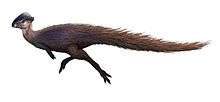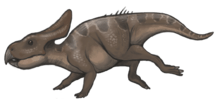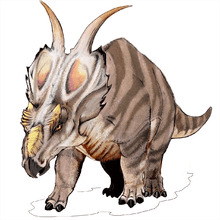Ajkaceratops
| Ajkaceratops Temporal range: Late Cretaceous, Santonian | |
|---|---|
 | |
| Holotype fused rostral and premaxillae | |
| Scientific classification | |
| Kingdom: | Animalia |
| Phylum: | Chordata |
| Class: | Reptilia |
| Clade: | Dinosauria |
| Order: | †Ornithischia |
| Family: | †Bagaceratopidae |
| Genus: | †Ajkaceratops Ősi et al., 2010 |
| Species: | †A. kozmai |
| Binomial name | |
| Ajkaceratops kozmai Ősi et al., 2010 | |
Ajkaceratops (pronounced "oi-ka-sera-tops") is a genus of ceratopsian dinosaur described in 2010. It lived during the Late Cretaceous in what is now Europe, in what was then the western Tethyan archipelago. The type species, A. kozmai,[1] is most closely related to forms in east Asia, from where its ancestors may have migrated by island-hopping. The generic name, Ajkaceratops, honors Ajka, a town in Hungary near Iharkút, where the fossils were discovered, combined with the Greek ceratops, meaning "horned face". The specific name, "kozmai", honors Károly Kozma.[1]
Description

The holotype, cataloged as MTM V2009.192.1, consists only of a few skull fragments, including rostral bones, fused premaxillae, and maxillae fragments (the beak and jaw fragments). These fossils are kept in the Hungarian Natural History Museum, in Budapest. Although the fossils are fragmentary, the paper describing Ajkaceratops estimated a body length of 1 m (3.3 ft).[1] Other material includes four predentary bones, cataloged as MTM V2009.193.1, V2009.194.1, V2009.195.1, and V2009.196.1; these are also believed to have belonged to Ajkaceratops, although they are proportionately smaller, and probably came from other individuals of the genus.[1]

Classification
The fossils most closely resemble those of Asian bagaceratopsids Bagaceratops and Magnirostris. Those similarities indicate Ajkaceratops is a ceratopsian related to the bagaceratopsids, but more primitive than Zuniceratops and the Ceratopsidae.[1]
Paleobiology
The fossils of Ajkaceratops were discovered in the Csehbánya Formation, which is interpreted as "a floodplain and channel deposit formed by variegated clay, silt with interbedded grey and brown sand, and sandstone beds". This strata dates to the Santonian stage, around 86 to 84 mya (million years ago). Ajkaceratops shared its environment with other dinosaurs such as Rhabdodon, nodosaurid ankylosaurs, Non-Avian theropods and enantiornithine birds, as well as eusuchian crocodiles, azhdarchid pterosaurs, bothremydid turtles and teiid lizards.[2]
See also
References
- 1 2 3 4 5 Ősi, Attila; Butler, R.J.; Weishampel, David B. (2010-05-27). "A Late Cretaceous ceratopsian dinosaur from Europe with Asian affinities". Nature. 465 (7297): 466–468. doi:10.1038/nature09019. PMID 20505726.
- ↑ Ősi, Attila; Butler, R.J.; Weishampel, David B. (2010-05-27). "A Late Cretaceous ceratopsian dinosaur from Europe with Asian affinities (supplementary data)" (PDF). Nature. 465 (7297): 466–468. doi:10.1038/nature09019. PMID 20505726. Retrieved 2010-05-29.


